For years now I’ve been an avid follower of Boran2’s weekly series Saturday Painting Palooza. Each week he explains and shows how he progresses through the creation of his paintings. How he decides on colors, shades, shadowing, and elements of his art. It’s been cool to watch over time how the quality and precision of detail in his work has gotten better and more refined, like we were learning along with him. A very cool online series :o)
All along the way he’s encouraged others to share their own creations within the comments of his diaries and in doing that helped I’m sure to foster greater creativity in those of us, certainly me, who enjoy reading and following along every week. In fact, there’s an occasional series by CabinGirl called Knit-a-palooza where she and others like Diane101 and Denim Blue share their handiwork and art.
Being something of a painter myself I’ve decided to do a short series on one of my works. I’ve been encouraged by Boran and others to have a go at sharing a little of how I do what I do. So, taking their encouragement to heart I’ve decided to do a step by step series on how I’ve done one “flame job” on a customer’s truck. I hope you like it….
Like a canvas, each car, bike, or boat I do has to have a solid foundation to lay my work on top of. In this case a Dodge pickup truck that is originally black. This customer wanted to change the color of his truck but couldn’t really afford the expense of also repainting the insides of his doors, hood, tailgate, etc. What I’ve done is to take his original color and add a mixture of blue and violet pearl tints to the black which upon first look still appears as black, matching all the door jambs, etc. But that when viewed in the sunlight has bursts of bluish and violet pearlesscence. This achieves both desires of the customer.
So first, I apply this ground coat of black with pearl…
After applying as many coats of the black pearl as needed and being satisfied that it’s even, so on, three coats of clear are applied on top of the color to seal it down and to give me a solid surface to work on that won’t disturb the color underneath. When all is thoroughly dry I sand down and flatten the clear coat, making sure not to sand through anywhere. This is necesarry for the graphics to adhere properly. Another effect of applying clearcoats in between elements of graphic images is that the finished product has an added effect of depth. This is important to the overall quality of the finished work.
Now the truck is ready for the flames. This customer, as is often the case, brought in a picture that gave me a good sense of what he was looking for. It doesn’t mean the picture will be copied exactly, though sometimes I do that, but just gives a direction to go in and a grasp of what colors and shapes appeal to the customer.. Here’s what I was given,
You can see that there are two overlapping sets of flames. The first is actually the same color as the truck. Which means that the only element that defines it is it’s outline. In most cases a flame is a combination of colors and blends, fades, airbrushed 3-D effects, etc. that are different from the base color. All of which generally recieve an 1/8 inch outline or border.
Here’s the part where I admit that there are some things that I don’t have the talent to pull off. Some things you can learn or at least fake. Others though, you are either born with or not. Let’s just say that my hand isn’t steady enough to use a pinstriping brush to create the 1/8″ outline, which could save an enormous amount of taping and time. On this job I decided to try and fake it. I’ll show how in a moment. But first, the next step is to lay out the outline of the flames with 1/8″ striping tape. The flames in the picture that I was given are called tribal flames. The ends, or licks of the flames as their called bend back in the opposite direction that the overall flame is going in. This is the outline applied to one half of the hood and one side of the truck<
Here’s where I attempted to outline the flames by taking my unsteady hand and brushing the outline color on using the applied taped outline as one half of the stripe, trying to achieve a line clean enough to pass off as brushed,
Unfortunately, even with the help of the tape line the finished painted outline was not clean and straight enough for my liking (I can be a bit picky).
Next week I’ll show how I went about getting the clean outline I wanted and how I was able to exactly duplicate the flame pattern onto the other side of the truck.
Peace

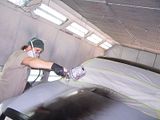
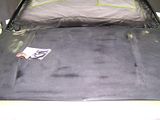
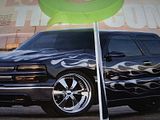
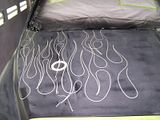
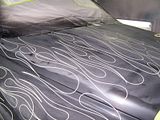
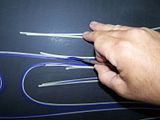


Thanks for the demonstration, supersoling! I grew up in an arts community and knew many of the painters by virtue of the high school jobs I had. Last weekend, we enjoyed a visit to a local gallery, where one of my kid brother’s friend’s landscape art was featured. I really admire the ability and skill of all you artists here at BT!
Thank you! :o)
I think I can say that I got my start by helping to create anti Vietnam War protest posters with my Mother :o) It gave me a sense of freedom of what I wanted to do which has served me pretty well now that I’ve become older (a relic really!!) LOL
Thanks Super, this is Pfascinating.
I nominate you and boran2 as the Opficial Pfrog pond bus painters.
Hopefully, I won’t need to provide a picture, just a bus. I know you guys will know just how to decorate it.
I miss the days of festive vehicles.
Thanks, Alice! :o)
A year or so ago I found out that Ken Kesey’s original Furthur bus had been pulled from the woods by his son and fellow travelers and were seeking volunteers to help restore it to it’s original condition, paint and all.
You know how sometimes, no matter how entrenched and committed to a standard life you might be living, an opportunity comes around that exerts such a strong pull on you that you actually consider bailing on all your commitments and responsibilities just to freewheel off to the other side of the country and live out a little dream? Damn! I wanted so much to make that call and head out there :o)
So if you provide the bus, I won’t pass it up twice :o)
Ah yes, there are many wonderful things I’d like to make happen. But for now that bus will have to remain in our dream world.
Let’s call ours “Pfurther.” Maybe I’ll see you there.
That is too cool! How do you think it would look on a silver Volvo wagon? 😉
I think I recall a conversation in the cafe about just this Volvo wagon a couple of years ago! :o)
If I remember corectly I advised painting it purple and putting a surfboard on top of it :o)
I’d stick with that!
Your memory is slightly phalty….it WAS a purple volvo. We’ve since acquired the silver one. What can I say? Once a dork, always a dork.
Dorks make the world go ’round :o)
“Your memory is slightly phalty”
Turns out the warnings on the paint labels are there for a reason, I guess. Just can’t remember :o)
There’s lots you could do with a silver wagon. Two tones are popular now. Sort of retro 50’s. You could take a nice tangerine pearl and paint the top of the car that color and separate the two with a little custom pinstripe. you could go as far as airbrushing the sides to look like a 50’s era chevy, airbrushed chrome moulding illusions and all.
Too bad I’m not closer. I might consider helping a dork out :o)
http://i2.photobucket.com/albums/y6/supersoling/0993_06.jpg
http://i2.photobucket.com/albums/y6/supersoling/custom.jpg
http://i2.photobucket.com/albums/y6/supersoling/23092005084424.jpg
http://i2.photobucket.com/albums/y6/supersoling/1955_Chevy_Nomad_custom.jpg
btw, this isn’t my work. I just did a quick search for you.
I’m just not much of a car person (or truck), but when I see these I think about the dark green, metal file cabinets or even the bland “almond” ones and think about how you could turn them into works of art! “Files Flambe'”
Ooh, that tangerine color is beautiful!
I thought pfalty was a reference to you being a sailor – old salt.
I heard that Van Gogh went a little batty from wetting his brushes by putting them in his mouth. You’re not doing that are you?
Never forget that mask.
Thanks!
Looking at the first photo, do you have to sand the original paint? I can see black on the paper covering the windows, so I know you’re spraying the pearly black, but the truck looks gray.
I’ll limit my questions to two:
How did you choose the blue of the outline?
What kind of brush do you use?
Okay, three:
What kind of paint do you use?
Thank you! :o)
I think I knew you’de have a few questions :o)
Okay, first. The outline I just made by throwing some white, transparent white (because it helps to clarify the color instead of muddying it), violet, and red together to make a nice Lilac shade because I think it goes well with black. That’s it. It’s a personal preference. I usually have freedom to do pretty much what I want within the basic outline of what the customer wants.
Second, the brush I use is a Mack double OO pinstriping brush, or a triple OOO brush, which makes a finer or thinner line. But like I pointed out, it’s not something I’m particularly good at and haven’t been able to improve much through practice.
Bonus question! :o)
All the paints I use are called base coat/clearcoat. Which means that the colors all dry fast and have a flat finish. The speed of drying is the most valuable aspect of it to me because it allows me to move on to the next color, layer, etc faster. It’s also good if I need to fix an Eff Up! :o) All these colors, once applied, get a clear coat to bury them which although shiny on it’s own, gets wet sanded down to a flat and fine finish that gets machine polished to a high gloss. It also eliminates the lines from taping that you would feel with your fingers. Essentially burying everything under one uniform finish. :o)
Oops, I missed one. And that makes 4 questions LOL!
Yes, you have to sand down the original paint. The gray you see is wet sanded primer that’s used to cover and fill the initial sanding and bodywork repair (dents, rust, etc) scratches.
Way Cool man,
I admire you guys who can do that stuff….
peace
Thank you Sir! :o) We all have our talents and admire those who can do things we haven’t done yet :o)
wow!!!!! I am in awe. You and others are so very talented I am in envy of your all….hugs super….
Thank you, Brenda :o)
Nice to see you…
kudos! and thanks, super.
it’s cool to see the process, and your narrative is great. it’s a lot more interesting that watching sausages…or laws… get made…:{)
how many coats do you anticipate start to finish? from your description, l suspect quite a few.
looking forward to the next installment.
Thanks, Dada. I appreciate that.
It will get clearcoated three times altogether, with each time consisting of three coats each. The last time the clearcoat get’s flattened and smoothed with a fine wetsand paper. Then of course, polished.
That is something I will never do! I even stopped buffing cars because I always burn the clear coat.
And I just can’t tell you how much I wuld like to know how to paint cars. But i know I will leave my finger prints (run downs) all over :0)
Good to see you!!
I think I burned through a clear coat just this past Friday :o) It happens, so pick that polisher back up!
As far as painting goes, what I do is for the most part learnable. Even the custom stuff. I can remember looking at other people’s work, shaking my head knowing (I was sure) that I could never do what they do. But most of it boils down to a series of stupid pet tricks that once combined create an image that appears more difficult than it is. I’ve found some interesting instructional videos on youtube. You should check them out. Who knows, maybe you might give it another go! Or a first try :o)
Good to see you too :o)
Ok, I will give it a try when I get there
Holy Shit!
What’s that, about 5000 miles?!
Tell me something, Cruz, are there dangers along the way? Like say, banditos, or government, hell, anti government forces for that matter, along the way? If so, how do you deal with it? That’s some long ride you have ahead of you.
I had a friend years ago who drove his VW Microbus from NY to Panama I think it was. He never mentioned much about any problems along the way. But it just seems too likely to happen. Or maybe it’s my American exceptionalist ignorance that sees boogey men everywhere :o)
It should be 8000 miles straight line. I know, by the time I get there I will be a hard ass :0) the main danger is in what is called the Darien Gap. But it is almost impossible to cross it (although some have in a two traction bike!) once in colombia, my main fear are the paramilitary, but since I travel with US passaport, dont expect much trouble from them. I heard that the safest is to go through the center of the country, which I assume is the panamerican highway. Get out of it, and you are in deep….
There are a few good videos in you tube. Google Burro has three wheels. you will love it. this is something I wanted to do all my life. But it all depends of how much money I can make in one year. If it doesnt happen, I will fly to Colombia and take buses back home. I already did it but from Ecuador.
Since I made up my mind to go back, I can’t think of anything else.
So, when do you see yourself leaving? A year from now? I ask for sentimental reasons because I’m a sentimental idiot :o) There are a few people left here at BT that I have had hopes of meeting someday. Not that that is a reality or possible, but I’ve gotten to know and care for a few of you guys :o)
I was just lamenting the loss of wanderlust and adventurism in Americans this last Sunday when I described my own family’s drive across the country when I was a kid, so your plan to wheel off 8000 miles to head back home brings a smile :o) I admire you for taking a monumental trip like this and I hope it becomes a reality for you :o)
You are no idiot supper. You are a great human being. As far as meeting, who knows, I might still head out east one of these days (although I am scared of Pennsylvania’s highways :0) But look at the bright side: now you can come to the end of the world, and you not only have a friend there, you will also have a place to stay, and someone to show you a great time. Also, you could also come in the winter here, and catch 3 summers on a row!!! :0)
Hey Cruz,
you made my day! I could see myself tripping down to Argentina for a few. Either way, it’s a nice thought :o)
You never know…
Well, I won’t dissapear. I will see you here. If you decide to come down, I do promiss this: good food, good wine, and good times!!! With 2 grand, you can go and come back, and have plenty to stay for at least 3 months.
…and what kind of bike is that? A BMW?
the one in the photo is a BMW, but just put it there. and I still have to buy one. A buddy of mine will help me with it (probably will rebuild the engine and trany) I hope to get a honda, hopefully a 1000. but anything over 750 will do.
holy shit! is right…..cruz, you’re going to be one saddle sore dude after that ride.
how long are you planning on taking?
good luck!
I guess 2 or 3 monthes. Up to Colombia it is going to be slowly. After that, specially from Peru on, it is lots of flat land and dessert. There I will be flying, ready to eat some carne asada :0) But that is still one or one and a half years away.
Yep, I will become a hard ass !
i’ve been waiting for someone to write a worthy sequel to El Che’s masterpiece 😉
Yeah!!! I know Hugo Gambini’s daughter (we went to the same school). Maybe she can give it to her dad :0)
Yay, SS finally shows his stuff!
Bravo! I know little about how this works and appreciate your showing us. Very cool, I look forward to seeing all the steps.
So that would be volume 2 next week, right? 😉
And thanks for the acknowledgment up top.
Yah, volume 2, Obi Wan! LOL
Thanks so much and you’re welcome :o)
I`ve come all the way phrom Phinland to see the phine phlames being aphixed on the phront of that phabulous pherrari.
Nice to see you putting a great series for us all to learn something from.
It’s really great to see how you go through the steps of a project…I never would have thought about the need to paint door jambs and all the other stuff when you switch body colors. Or how you would go about getting around needing to do all that.
Looking forward to the next installment.
The palooza phenomenon has gone viral!
Great work, super. looking forward to seeing the rest of it come together.